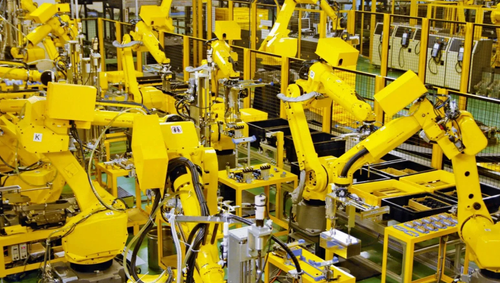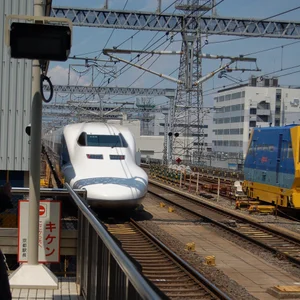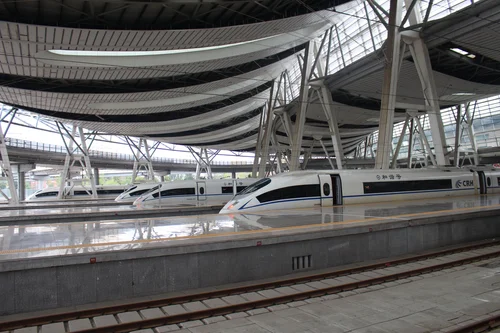Japan-China Business Relations: Symbiotic Pragmatism for the Asian Century?
Jun 17
Written By Ulrike Schaede
The trade war between U.S. and China expands and extends almost daily, giving the word “decoupling” a new, and for some increasingly scary, meaning. Today’s news is that China’s two leading technology universities can longer purchase or access U.S. equipment and software without U.S. government approval. While many find these measures justified to level the playing field, others worry that the U.S. decoupling moves may backfire. One doomsday scenario is that trade relations in Asia are becoming more independent from U.S. markets and companies, and the post-COVID recovery in Asia may happen without the United States. It has long been forecast that the 21st century will be the Asian century. If America doesn’t pay attention, it may well be left hung out to dry while Asia reorganizes and grows its own trade relations and consumer markets.

The Japan-China Connection
The main – and often overlooked – engine feeding into this scenario is the newly emerging Asian trade dynamics, anchored on pragmatic and symbiotic business relations between China and Japan. Perhaps needless to say, these are the world’s second- and third-largest economies. Pre-COVID, their joint GDP was about $15 trillion, compared to $18 trillion in the U.S.. What is more, the two economies are increasingly intertwined by way of a new type of trade dependencies in the Asian supply chains. As U.S. policy-making remains based on 20th century, bilateral, market-to-market thinking, Asia is building its own 21st century network and trade economy. Clearly, both countries still need U.S. market and technology ideas as well as consumer spending. But, should those dry up, it is conceivable that Asia will just turn to or build greener pastures without the U.S.
Relations between China and Japan are as complicated as they are long, dating back to the 7th century at least. Japan has borrowed much from Chinese culture: the written language, Buddhism, and even ramen noodles were originally China imports. In contrast, Japan’s spoken language and grammar, Shintoism and sushi are as homegrown as the Toyota Production System. There are many painful scars from this history, in particular World War II, that run deep and continue to challenge diplomatic relations. There is also a new geopolitical angst concerning China’s rising military power and apparent appetite for expansion. And, the two peoples are quite different in terms of social norms of behavior, preferences and mindset.
But, as much as history is complicated, when it comes to money and trade the two countries have found a new, mutual beneficial equilibrium ruled by pragmatism, as I argue in Chapter 5 of my new book. Perhaps ironically, this situation is symbiotic and stable, not in spite of but because it is highly unequal. Both sides have something the other side needs. While the people may not be best buddies – though more on Gen-Z below – there is a lot of mutual pragmatic give-and-take in business relations, as companies are finding ways for both to win.
Trade and FDI Between Japan and China: A Pre-COVID Snapshot
In 2018, the bilateral trade between Japan and China was almost balanced, with roughly $178 billion in exports and imports when trade through Hong Kong is included. For Japan, China is by far the largest trading partner, accounting for about 25% of both exports and imports. And 2018 data suggest that for China, Japan was the second largest export destination and third largest import source, after the U.S. and South Korea.

The point with this table is to highlight that over the past two decades, a new situation has emerged whereby China and Japan rank first for each other in a variety of categories. It is still true that the U.S. has long been the largest destination for Japanese foreign direct investment (FDI), dating back to the U.S.-Japan trade wars of 1980s and 1990s when the U.S. established trade rules that incentivized Japanese companies to open production sites in the U.S.. But more recently, Japan has recently become by far the largest foreign operator of business sites in China, with over 32,000 sales offices, factories and partial stakes in companies in China. Conversely, for Japan this number means that China accounts for 43% of Japan’s offshore businesses sites (even though the scale of Japan’s operations in the U.S. is still larger).
The Northeast Asia Trade Triangle: Japan - China - Taiwan - Korea
This new China-Japan relationship does not exist in a vacuum. Rather, it is part of a larger web of business relations that has been built over the past two decades in Northeast Asia. It is fair to say that there is a new division of labor in Asia: China has become Asia’s assembler, and Japan the specialized manufacturer of high-tech components and the source of innovation and ideation. As more and more Japanese companies are pursuing an aggregate niche strategy, they lead important product categories in the provision of deep-tech input components and materials. These deep-tech input materials reach China mostly via the route of Taiwan and South Korea. There, advanced films, adhesives, and components are built into input parts, such as the screen of your cell phone or computer. Japanese companies look back on over 50 years of experience in these difficult-to-make and difficult-to-imitate inputs, and to this are now adding new capacity-building in deep-tech innovation.
So we get a trade triangle: South Korean and Taiwanese firms buy the input resources, turn them into parts (often using highly advanced Japanese production machinery), and then sell these to companies in China for assembly.

Trade Relations in Northeast Asia in 2018,
in US-$ billion
, constructed from UN Comtrade and Taiwan Bureau of Trade,
see my book for details.
The Business Reinvention of Japan: How to Make Sense of the New Japan and Why It Matters 1st Edition
by Ulrike Schaede (Author)
Even as the trade between China and Japan has been quite level for a few years now, South Korea and Taiwan have a growing trade deficit with Japan, and China has a growing trade deficit with South Korea and Taiwan.
Japan-China Symbiosis
The reason that this trade mesh has been growing continuously over the past two decades is that its two cornerstones, China and Japan, both need it and enjoy it. Two factors make this new relationship symbiotic. The first is sheer size, including the size of China’s consumer markets and the amount of trade that flows between the two countries. And the second is their different positions in the global value chains. And it is this difference that creates valuable synergies.
China, not unlike Japan in the 1960s and 1970s, achieved rapid growth through export promotion and low-cost manufacturing of consumer goods. Government subsidies, high domestic savings, and technology adaption were the main drivers, though with the obvious differences that China is not a democracy and most of its large firms are state-owned enterprises. However, whereas Japan in the 1960-1980s had closed down its markets to any foreign investment, China’s growth has depended critically on foreign capital and knowledge, and China happily became the world’s assembler. This means that Japan grew by developing its own, entirely domestic vertical production capabilities, with constant upgrading and organizational learning. In contrast, Chinese companies copied the technologies that foreigners brought into the country, but then specialized in the lower value-added, lower cost parts of value creation, i.e., final assembly. Thus, China developed a system built for import, assembly, and reexport, whereas Japan had developed a complete domestic value chain from product design to final sale.




This put Japan at an advantage when companies decided to relinquish low-tech consumer end product markets and move upstream into deep-tech technologies and advanced materials – from the assembly of toaster-ovens to advanced components and sensors, so to say. Few Japanese companies make semiconductors today, but there are certain steps in the global production of semiconductors that rely to 100% on a technology from Japan. Having built capabilities across the entire value chain in its version of the “developmental state” means that Japanese companies can in fact exit the lower value-added activities and switch into the higher margin, upstream niches. China now wants to do something similar, and turn from the “factory of the world” to its own, independent economic powerhouse. This was proposed in its 2015 industrial policy program “Made in China 2025”, which identifies industries such as pharmaceuticals, automotive and aerospace industries, semiconductors, IT and robotics as growth sectors. All of these are large-scale industries and encroach on Japan’s bailiwick. However, today China does not have the capabilities to produce all inputs at global quality levels. Enter Japan.
In the medium run, the industrial structures and goals of the two countries are more complementary than competitive. Given China’s population size and pressures to scale fast, China’s focus for 2025 is on industries that promise large volume and huge manufacturing installations. The areas that Japanese companies are focusing on in the aggregate niche strategy are small and demand different innovation and manufacturing capabilities. Given Japan’s shrinking population and labor shortages, scale is no longer as important as profit margins, so it can afford to zoom in on these smaller niches.
A second, perhaps quite obvious, reason for the symbiotic pragmatism underlying the China-Japan business relations is that China’s #1 aspiration right now is not be dependent on the U.S.. Being dependent on Japan for a set of critical input parts may not be desirable, but it is much preferable over being depending on the United States.
Will this last? Naturally, some Chinese companies are exploring the technologies and processes that are currently procured from Japan. It is unlikely that Japan’s aggregate niche strategy will last forever, as markets are dynamics and coalitions shift constantly. But as of 2020, this situation seems to be in a medium-run equilibrium. Chinese companies still lag behind Japanese companies in some of these advanced materials and components, and of course none of these competitors is sitting still. Even though from the distance a rising China may look like a threat to Japan, currently the aggregate niche strategy affords Japan’s leading companies a nice competitive advantage. Even under “Made in China 2025”, China still needs Japan. And for Japan with its aging and shrinking society, China has already become the largest export and consumer market.




Asia’s Gen Z: “What history?”
And, finally, there is also the generational shift, and the new “hipness” factor that Japan enjoys in Asia. The table above showed that China is Japan’s largest trading partner in tourism, and almost half of foreign students in Japan hail from China. And, Japan’s stellar reputation for high-quality products and brands, from cosmetics to shoes, has turned “Made in Japan” labels into the new aspiration of upward-bound young Asians, and young Chinese are no exception. These growing cultural ties are underlying the broader economic nexus in East and Southeast Asia. First, there is a cultural affinity and shared fashion preferences among up-and-coming young Asian. And, the milennials — and certainly Gen-Z that was born after China had already launched its rise in the 1990s – carry less of a history grudge.
Many have wholeheartedly embraced Japanese pop culture, beauty products, and fashion, as the quality of Japanese products has made Japanese cosmetics, movies, and brands the #1 symbol of luxury and accomplishment. Travel to Japan, eating raw fish, getting a Japanese-style haircut, and wearing made-in-Japan Uniqlo are signs of accomplishment across Asia. Many quietly, and some even openly, agree with this observation of an industry executive in Asia: “Japan is the place the kids are looking up to”.
The Post-COVID Asia Trade Triangle
Then what does this mean for post-Corona economic recovery in Asia? Given the structure and stickiness of the supply chain network in Asia, barring a huge disaster or war, it appears that decoupling is effectively impossible in Asia. Too many economies are too dependent on each other and the supply chain network they have created over the past three decades, for anybody to be interested in breaking these down. Each of these countries has their own domestic baggage to carry, but in terms of regional recovery of economic activity, it appears that Asia is tied together. A recent IMF forecast predicting vastly differential growth rates in Japan, Korea and China seems somewhat implausible.
As long as there no unexpected major shocks – an extension of the pandemic, an earthquake, etc. — it is in the interest of both Japan and China to keep a good thing going, and if need be, without the querulous U.S.. And as U.S. consumer markets fall flat due to a severe recession, they view the exploration and growth of new markets, such as in South East Asia, as ever more important. Of course, counterbalancing this business bliss is the growing fear about world peace and world order stability, as well as global health. But ceteris paribus, just in business terms, it may just so happen that Asia will launch its economic recovery without the U.S. consumer as their core address.

Ulrike Schaede
How Japanese Companies have Reacted to the Rise of China
To escape the growing price competition for consumer end products in Asia, over the past two decades Japan’s leading companies have pivoted away from those markets and into advanced upstream input materials and components. While there is no “Japan Inside” label on the final products, this has made Japan a critical technology anchor of many global supply chains. The leading Japanese companies have adopted an “aggregate niche strategy” that allows them to occupy large market shares in a series of deep-tech niches. And, to switch to these new positions on the technology frontier, they have also begun to change their internal management processes and HR practices. At a time of decoupling, shifting trade regimes and the digital transformation, Japan continues to be a global manufacturing force to be reckoned with.
For a related op-ed piece, see Brad Glosserman in the Japan Times
Book reviews:
Dec 18, 2020
A business book about Japan that is both practical and polemic.
Stephen CoxClick here to view Stephen Cox’s profile
Stephen Cox
Japan market strategist / business transformer
Published Dec 18, 2020
+ Follow
No alt text provided for this image
An excellent book that looks from the granular to the great to illustrate how Japan’s slow-but-sure re-processing of innovation and evolution will tame change and return it to the leading edge of the global economy.
This is a tortoise & hare story of the challenges and opportunities of Japan’s business world.
In it, Professor Ulrike Schaede (UC San Diego) makes a convincing case that it is the tortoise’s granular attention to defining detail, to creating consensus, and to patient on-boarding that enables it to design an economic model for the future. Indeed, it is Japan’s in-it-for-the-long-run mindset, seeking long-term corporate and social benefit while eschewing the outside world’s overwhelming focus on short-term shareholder return, that will ensure Japan’s staying power, and allow change without the social disruption seen elsewhere.
Professor Schaede artfully describes the underlying, difficult to define, but ever-present cultural and social drivers of business that I believe anyone contemplating the market must come to understand (though few actually do). This extremely useful practical guide occupies much of the early part of the work, and serves to set the context for the weightier new insights that form the premise of her book later on.
Her premise is an emerging reinvention of business that will reposition Japan’s global and domestic businesses as unique suppliers of critical new components in global value chains. She posits that these ‘aggregate-niche strategies’ will carve out new value in the world economy for Japan.
She further argues that it will do so while leveraging its traditional strengths and products even as they wane in the face of new competition and commoditization. To illustrate this deliberate duality of purpose, she references Harvard Business School Professor Michael Tushman's ‘explorers and exploiters’ concept.
For transparency, I should note that part of my admiration for the book stems from Dr. Schaede’s nod to this concept, which has long informed my own approach to innovation in managing businesses in fast changing environments.
Whether the aggregate niche strategy exists as a deliberate design, coordinated enough to rejuvenate Japan Inc, or is more of a coincidental convergence of institutional initiatives (which would require a healthy dose of serendipity to succeed), is still an open question for me. However, when held up to the light of Abenomics, and the reforms of Prime Minister Koizumi before that, Professor Schaede’s premise seems more than plausible. It could even be the inevitable outcome of the slow, purposeful and opaque movements of the faceless dancers that make up what Karel Van Wolferen called ‘The System’ in his book The Enigma of Japanese Power.
===
After two decades of reinvention, Japanese companies are re-emerging as major players in the new digital economy. They have responded to the rise of China and new global competition by moving upstream into critical deep-tech inputs and advanced materials and components. This new "aggregate niche strategy" has made Japan the technology anchor for many global supply chains. Although the end products do not carry a "Japan Inside" label, Japan plays a pivotal role in our everyday lives across many critical industries.
This book is an in-depth exploration of current Japanese business strategies that make Japan the world's third-largest economy and an economic leader in Asia. To accomplish their reinvention, Japan's largest companies are building new processes of breakthrough innovation. Central to this book is how they are addressing the necessary changes in organizational design, internal management processes, employment, and corporate governance. Because Japan values social stability and economic equality, this reinvention is happening slowly and methodically, and has gone largely unnoticed by Western observers. Yet, Japan's more balanced model of "caring capitalism" is both competitive and transformative, and more socially responsible than the unbridled growth approach of the United States.
Editorial Reviews
Review
"Ulrike Schaede's new book combines an invaluable primer on Japanese business culture with a striking analysis of Japan's little understood strategy for producing enduring economic strength based on manufacturing excellence and constant, managed change. I came away with renewed admiration for the country's political and corporate leadership, and Japan's ability to forge a successful economic future despite the many daunting challenges one often hears about." -- Ambassador Ira Shapiro, former U.S. Trade Negotiator with Japan ― former Chairman of the National Association of Japan-America Societies
"This authoritative and sophisticated account of how Japanese companies have quietly reformulated how they compete in the global economy is a timely reminder why we need to pay attention to Japan. Japanese companies and their technologies remain, and will continue to remain, critically relevant in our fast-changing world." -- Alberto Moel ― VEO Robotics
"For more than a generation, the outside world has been ready to write off Japan's economy as yesterday's story, in contrast to the tomorrows being created elsewhere, especially in China. Ulrike Schaede clearly and convincingly lays out how out-of-touch that judgment is―and how much more impressive the creativity, flexibility, and re-invention of the Japanese business system look when examined up close. The crispness and concision of the book make it a pleasure to read, and its originality will make it useful for anyone who wants to understand the next stage in global business." -- James Fallows ― The Atlantic
"Schaede truly understands Japanese business strategy and culture. With deep insights and keen analysis, she offers an update on how Japanese companies are evolving to compete in the new global economy. And, she shows how they carefully harmonize social stability with economic success." -- Kyota Omori, Chairman ― Mitsubishi Research Institute
"A gem! Schaede links corporate culture to incentives and outcomes, and shows how Japanese firms have kept the tight corporate culture that makes things right, but add elements of the loose culture that makes the right things. She gives concrete examples of Japanese firms that got it right and how they did it." -- Robert Alan Feldman ― Tokyo University of Science
"Japan's economy and its evolving business systems matter, and this insightful evaluation explains how and why. A definite read." -- Hugh T. Patrick, Chairman, Center on Japanese Economy and Business ― Columbia Business School
"Schaede's book offers an up-to-date, intriguing, rich, and easy to read account of changes in Japanese business over the last 20 years. As such, it deserves a wide readership and it will definitely enter my reading list for students." -- Harald Conrad ― The Journal of Japanese Studies
About the Author
Ulrike Schaede is Professor of Japanese Business at the School of Global Policy and Strategy, and Director of the Japan Forum for Innovation and Technology, at the University of California San Diego. She is the author of seven books, including Choose and Focus: Japanese Business Strategies for the 21st Century (2008).
Product details
Publisher : Stanford Business Books; 1st edition (June 16, 2020)
Language : English
Hardcover : 280 pages
ISBN-10 : 1503612252
ISBN-13 : 978-1503612259
Item Weight : 1.3 pounds
Dimensions : 6.3 x 1.2 x 9.1 inches
Best Sellers Rank: #767,206 in Books (See Top 100 in Books)
#133 in Comparative Economics (Books)
#253 in Business Infrastructure
#272 in International Business (Books)
Customer Reviews: 4.6 out of 5 stars 10 ratings
Videos
Help others learn more about this product by uploading a video!
Upload video
More about the author
› Visit Amazon's Ulrike Schaede Page
Ulrike Schaede
Follow
Discover books, learn about writers, read author blogs, and more.
How would you rate your experience shopping for books on Amazon today?
Very poor Neutral Great
Customer reviews
4.6 out of 5 stars
4.6 out of 5
10 global ratings
5 star
74%
4 star
13%
3 star
13%
2 star 0% (0%)
0%
1 star 0% (0%)
0%
How are ratings calculated?
Review this product
Share your thoughts with other customers
Write a customer review
Top reviews
Top reviews
Top reviews from the United States
Steven Forth
5.0 out of 5 stars An important study of national industrial strategy and change management with broad relevance
Reviewed in the United States on August 22, 2020
Verified Purchase
Who should read this book?
- Business and technology leaders of companies with a wide portfolio of technology offers
- Business and technology leaders of companies that compete to control supply chains (companies compete within supply chains for profit share; supply chains compete for market share)
- Investors, especially those in private equity
- National policy and strategy leaders working on the creation and implementation of national industrial policies
- Those interested in the economic dynamics of East Asia (China, South Korea, Taiwan, Japan)
- Those interested in the evolution of technology and technology based economies
- Those interested in the impact of demographics on economic structure and performance
- Anyone who lives and works, or who has lived and worked in Japan
I tick a number of these boxes and found this book completely engaging. I spent a decade in Tokyo during the 1980s bubble and left in part because of the hubris of Japanese business leaders at the time. I have made a number of investments in Japanese software and media companies over the years. My wife is Japanese and we visit Japan most years.
Ulrike Schaede has a deep knowledge of the Japanese economy, politics, companies and culture, but wears this knowledge lightly and let's the facts and story tell itself.
Many people have written off Japan and see it as a declining power, with a shrinking economy, mired in debt, suffering from lost decades. China absorbs almost all the attention and there are some analysts who think that Japan (and the EU) have little role to play in the future of technology (see AI Superpowers by Kai-Fu Lee). This book shows how much has been changing in Japan over the past two decades. Japanese companies have emerged as the control centers for many of the key supply chains that global technology depends on. This became apparent after the 2011 Tohoku earthquake. This is not an accident but a strategy, one that Schaede refers to as niche aggregation (supply chain control might be a better term).
Enabling this strategy is requiring major cultural change. Schaede analyses this using Michele Gelfand's tight-loose theory of culture. Some countries, like Japan, have tight cultures where conformity is highly valued. Others, like the US, have loose cultures where people have more freedom to challenge norms (if you read this as a value judgement you are too deeply embedded in your own culture to understand the strengths of the other approach). Schaede looks at how society, government and leading companies in a tight culture are making the changes needed to execute on a strategy that requires continuous innovation.
The new strategy also required a new approach to corporate financing and Schaede looks at how the main bank led debt financing approach that served Japan well during the postwar boom contributed to the 1980s asset bubble and then slowed the transformation to new models for wealth creation. Private equity now plays a much more important role, but that this is private equity Japan style with goals, values and behaviors quite different from US funds.
The book include some mini case studies of companies that have succeeded in the transformation and others that are struggling. AGC (formerly Asahi Glass), Recruit, Sony, Keyence, Fanuc, etc. are all mentioned. I would like to go deeper on these studies and I am hoping that there are cases available.
All of the mature economies (including China and soon India and Brazil) are entering a period of population decline. This could be one of the most hopeful developments in history and lead to wealthier, more humane, creative societies that live as constructive parts of the environment. Or it could by a dystopian wreck. Japan is farther along this road than any other country and it is important that we study and learn from it. This book is a good place to begin that learning.
Read less
3 people found this helpful
Helpful
Report abuse
L. Wang
5.0 out of 5 stars Award winning book!
Reviewed in the United States on May 10, 2021
Verified Purchase
This book just won the Ohira Memorial Prize. Better buy a copy before it sells out. Great insights about contemporary Japan. Even tells you things about the escapee Carlos Ghosn. Written by someone who really knows the country, the society and the economy.
Helpful
Report abuse
No comments:
Post a Comment